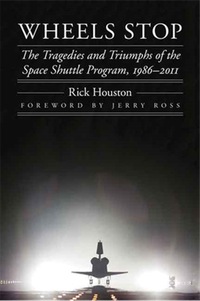Review: Wheels Stopby Jeff Foust
|
| “It was a time of creativity, innovation, and doing one-of-a-kind missions,” Kelso said of the early post-Challenger missions. “The flights we did in that time period had never been done before or since.” |
In Wheels Stop, author Rick Houston revisits the Space Shuttle and the wide range of missions it performed. The title alone might indicate a book about the end of the Shuttle program, but he reviews a much broader swath of the program’s history, starting with STS-26, the first post-Challenger mission, and going through STS-135 in 2011. The book is not a dry, mission-by-mission recounting of the more than 100 missions flown in the post-Challenger era, but a more narrative examination of shuttle history based heavily on interviews with astronauts, flight controllers, and others involved with the program.
Rather than do a strictly chronological history of those Shuttle missions, Houston instead provides a more thematic organization to the book, writing chapters about the different types of missions the Shuttle flew. After the chapter about the return-to-flight STS-26 mission, Houston devotes a long (more than 60 pages) chapter to the scientific and military missions the orbiters flew in the late 1980s and well into the 1990s. These missions are often overlooked today, overshadowed by the Shuttle’s later roles in assembling the International Space Station, but they were critical for getting the Shuttle program back up to speed. “It was a time of creativity, innovation, and doing one-of-a-kind missions,” former flight director Rob Kelso recounts in the book. “The flights we did in that time period had never been done before or since.”
Another chapter is devoted to the various Shuttle missions to deploy and later service the Hubble Space Telescope, including the efforts to get the fifth and final servicing mission restored after NASA announced in 2004 it would not fly the mission. Later chapters examine the Shuttle-Mir missions and the early ISS assembly missions. The Columbia accident and the return to flight are covered in separate chapters, as are the remaining missions to assemble the ISS and, then, STS-135 and the closeout of the program.
Houston doesn’t try to give each mission equal treatment: some missions are covered in great detail, and others briefly mentioned at best. For example, STS-135 understandably gets a full chapter, but the preceding few missions get little mention, even STS-134 and all the attention surrounding its commander, Mark Kelly. However, Houston’s interviews offer a personal view of the missions and the Shuttle program in general, and in some cases don’t shy away from controversy. Charles Camarda, who flew on STS-114 and was the director of engineering at the Johnson Space Center during preparations for the following mission, STS-121, in 2006, discusses being removed from his position shortly before that launch: officially for unspecified “managerial behavior”, although Camarda suspects that it had to do with his disagreement with the decision by then-administrator Mike Griffin to launch the mission despite concerns by Camarda and others that there was still a serious risk of foam coming off the external tank. (Griffin says in the book that Camarda’s reassignment to the NASA Engineering and Safety Center “had nothing to do with the decision to fly or not fly on STS-121.”)
| Ross writes in the foreword that he believed that if the Shuttle continued to fly, “there was a fairly high probability of losing another vehicle and crew.” |
While Wheels Stop provides an interesting, personal look at the post-Challenger history of the Shuttle program, it stumbles a bit at the end when Houston examines the end of the program and the uncertain future of NASA’s human spaceflight efforts. He makes several errors here, from claiming that Griffin became NASA administrator in the immediate aftermath of the Columbia accident (he took the job more than two years after the accident, and more than a year after President George W. Bush announced the Vision for Space Exploration) to suggesting that the major policy shift made by the Obama Administration was first announced in the president speech at the Kennedy Space Center (many of those policy elements were already in the administration’s budget request released two and a half months earlier.)
To this day, some lament the decision to end the Space Shuttle program despite its expense and the two fatal accidents, arguing that the program was flying quite well in its final years. Among those who don’t agree with that is former astronaut Jerry Ross, who, in the book’s foreword, said he believed that if the Shuttle continued to fly, “there was a fairly high probability of losing another vehicle and crew.” For better or for worse, the Space Shuttle is now part of history, and Wheels Stop offers an often fascinating review at what those orbiters accomplished.
